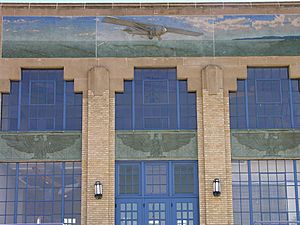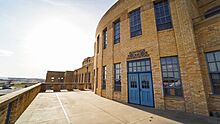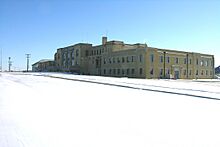Kansas Aviation Museum facts for kids

A view of the planes on the ramp outside the museum.
|
|
| Lua error in Module:Location_map at line 420: attempt to index field 'wikibase' (a nil value). | |
| Former name | Wichita Municipal Airport |
|---|---|
| Established | April 19, 1991 |
| Location | 3350 George Washington Blvd Wichita, Kansas 67210 USA |
| Type | Aviation Museum |
| Visitors | 42,205 (2023) |
|
Administration Building
|
|
| Location | McConnell AFB, Wichita, Kansas |
| Area | less than one acre |
| Architect | Glen H. Thomas |
| Architectural style | Art Deco |
| NRHP reference No. | 90000908 |
| Added to NRHP | June 11, 1990 |
The Kansas Aviation Museum is a fun place for airplane lovers in Wichita, Kansas. It's located in a special building that used to be the city's main airport terminal from 1935 to 1954. The building itself is famous for its cool Art Deco style, designed by architect Glen H. Thomas.
Because Wichita is so important to the history of airplanes, the city gave the street the museum is on an honorary name, "Air Capital Blvd," in 2024. The museum is home to many amazing aircraft. You can see a giant B-52D Stratofortress bomber, a KC-135 Stratotanker refueling plane, and one of the first Learjet 23 business jets.
In 1990, the building was added to the National Register of Historic Places. This is a list of important historic places in the United States that are worth protecting.
Contents
From Busy Airport to Famous Museum
The museum's story begins long before it was a museum. It started as the main airport for Wichita and saw many exciting moments in aviation history.
Building an Airport
Back in 1927, the city of Wichita bought 640 acres of flat prairie land. This spot was already used for airshows. In 1930, the city's mayor, L.W. Clapp, started the construction of the main terminal building.
However, progress was slow because of the Great Depression, a time when many people lost their jobs and money was tight. In 1934, the U.S. government's Works Progress Administration program provided money to finish the project. The beautiful new airport terminal finally opened on March 31, 1935.
World War II and Famous Visitors
During World War II, the airport became very important for the military. In 1941, the United States Army Air Corps leased the airport. They added a control tower on top of the building and built new wings on each side of the terminal.
The airport became incredibly busy. It was used to deliver thousands of new airplanes built by Boeing, like the Kaydet trainers and the giant B-29 bombers. By 1944, a plane was taking off or landing every 90 seconds!
Many famous people traveled through the terminal, including the pilot Charles Lindbergh, dancer Fred Astaire, and aviation pioneers Amelia Earhart and Howard Hughes.
Becoming a Museum
After the war, the airport went back to being used by regular passenger planes. In 1951, the United States Air Force took over the airport for its new B-47 jets and renamed it Wichita Air Force Base. A new airport for the city, Wichita Mid-Continent Airport, opened in 1954.
The Air Force used the old terminal building until about 1984. After that, the building was left empty for several years. Luckily, in 1990, a group of people who loved aviation history formed the Kansas Aviation Museum. They worked hard to fix up the old building and turn it into the museum it is today.
Explore the Aircraft Collection
The Kansas Aviation Museum has an impressive collection of planes that you can see up close. What makes this museum extra special is that it lets visitors go inside some of the planes! It also holds a "Play on a Plane Day" once a year.
Some of the aircraft on display include:
- WB-47E Stratojet
- B-52D Stratofortress
- KC-135 Stratotanker
- Boeing 727
- Boeing 737-2H4
- Republic F-84F Thunderstreak
- Beech Starship
- Cessna T-37
- Learjet 23
- Lockheed T-33
- Stearman 4D
- 1920 Laird Swallow
- 1944 Beech Staggerwing
On June 17, 2025, the museum building had some minor water damage from a storm, but it continues to welcome visitors.
Gallery
See also
- Cosmosphere in Hutchinson
- Combat Air Museum in Topeka
- Mid-America Air Museum in Liberal
- Kansas World War II army airfields
- List of aerospace museums
- List of museums in Kansas




